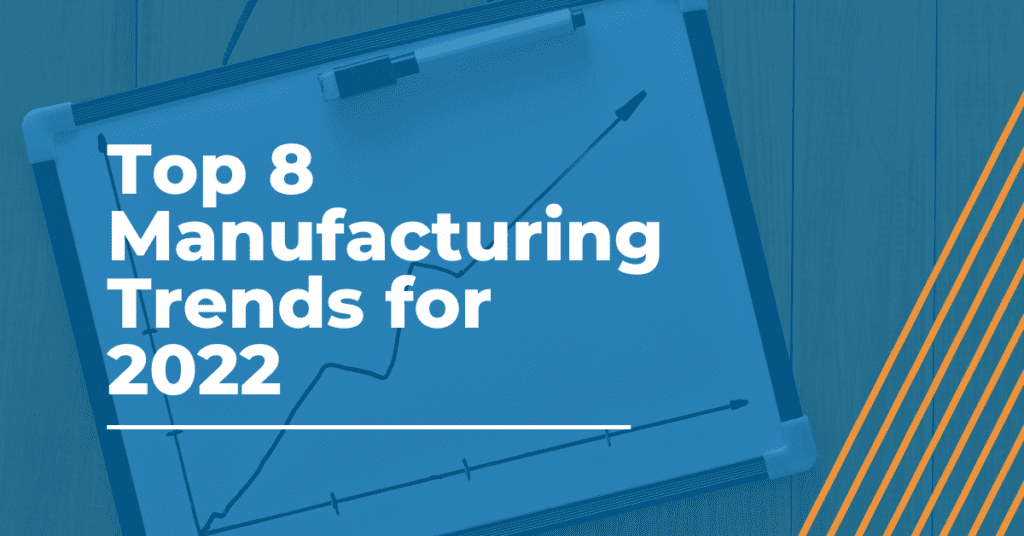
Top 8 Manufacturing and Automation Trends for 2022
Over the last few years, many industries have changed their thought processes and had to adapt to situations developing around them, none more so than the manufacturing industry. With the initial impact of Covid-19 and its stoppage of in-person work, mixed with later supply chain issues, American manufacturing has needed to adapt quickly. With 2022 in full swing we have eight automation and manufacturing trends to look out for, according to a recent report from the National Association of Manufacturers.
The Labor Shortage
Since spring of 2021, more than 33 million Americans have quit their jobs. Many have speculated as to how or why this Great Resignation is happening; poor corporate culture, high inflation rates or merely workers taking the opportunity to decide on another career path. Whatever the case might be for an individual, it’s impossible to ignore the growing gap in jobs needing to be filled and unsatisfied workers.
For manufacturing that means Americans need to rethink the ways in which they produce products. According to experts, this problem is not going anywhere. The labor shortage is predicted to continue well beyond 2022, resulting in an estimated 2.1 million unfilled manufacturing jobs by the year 2030. The very best way to reduce labor and increase productivity is through automation. Automation is the key for manufacturing moving forward and the willingness for companies to adapt sooner rather than later.
Supply Chain Challenges
Another of the manufacturing trends involves more of the same supply chain issues that occurred in 2021 continuing through this year. There are many factors that are causing global supply chain disruptions and long lead times are not going anywhere soon. Finding a larger supplier pool or working with closely located suppliers can help reduce these troubles.
Some experts are hopeful for 2022 to pose a turning point. Companies are taking large strides to invest in new technology that will drive efficiencies and lower costs. Of course as more automation is implemented into the supply chain, the technology will continue to improve itself.
Leadership Through Disruption
Leadership has become an even more important factor in the success of a company in recent years. Specifically, manufacturing companies now must have leaders who are able to help solve day to day issues, while also having the strategic vision to continue to improve through new technology input. A great way to learn more about emerging technologies is being well connected to other thought leaders and creating a network of similar minded people who are trying to solve the same headaches.
At AMS, being a company led by transparent thought leaders opens up opportunities for success. Following principles like those laid out in Traction (which we implement in everything we do here at AMS), can lead teams toward their goals together. Forming an inclusive company culture has never been as important and will ultimately lead to more success. Nurturing corporate culture is one of the top manufacturing trends.
Cybersecurity
While the landscape of business continues with more online technologies and advancements, simultaneously cybersecurity crimes are becoming more and more common. On top of financial issues, cyberattacks cause safety hazards, loss of reputation, damage to customer relationships and more. Manufacturing companies, because of their innate use of IT and OT systems, are especially vulnerable.
Allocating funds for prevention and insurance is the best way to help reduce security risks. Falling victim to any one of these situations could disrupt operations, putting processes, equipment and people in harm’s way and ultimately cost a significant chunk of revenue. Being able to prevent these types of attacks could be the difference in a business’s survival. Cybersecurity insurance helps create options in the event of an attack. Enlist the help of professionals to identify vulnerabilities in networks and take steps to close any gaps.
Digital Transformation
Adapting to the digital world is simply a must. The 4.0 revolution is already underway, looking for innovative new technologies is the way forward. Converting more of the supply chain and internal operations into digital threads can help with tracking, boost resilience and give insight into operations that can lead to better informed decisions.
Culture
More often than not, company culture is driving the morale and efficiency of teams. Having a team that is diverse with leaders who understand their roles and goals can have immense success. Include people of all ages, genders, races and ethnicities, abilities, sexual orientations, education, life experiences and socioeconomic backgrounds into a culture. With a diverse workforce in place and the proper support, anything can be accomplished.
At AMS, we continue to look for employees who desire to work in a diverse environment with the ability to problem solve. Compiling a team of diverse individuals with their own backgrounds, experiences and ideas is not an easy thing to accomplish but we are well on our way. By being an inclusive company culture that follows Traction principles, our company will continue to work towards a diverse workforce.
Mergers and Acquisitions
With the difficulties of the pandemic displacing labor and supply efforts, larger manufacturing firms have needed to expand their operations and gain market share. This shift is another of the top manufacturing trends. Buying smaller firms has been the easiest way to consolidate processes and facilities in the name of efficiency. Smaller firms who are able to communicate their value beyond revenue including culture, customers and technology can easily position themselves into a great valuation.
Opportunities in Automation and Manufacturing Trends
In these uncertain times, being brave and willing to take risks on potential opportunities are going to separate companies from their competitors. Keep an eye open for things such as tax credits to claim $80 billion in government incentives available to businesses in the U.S. every year. It’s also wise to watch for emerging technologies that can be responsive, adaptive, agile and competitive. Contact us to learn more and move forward in 2022.
